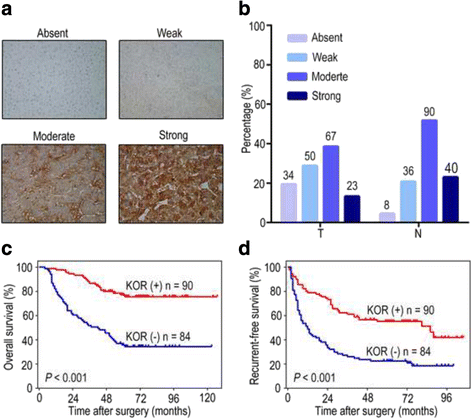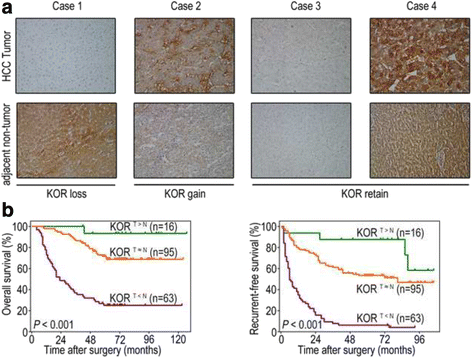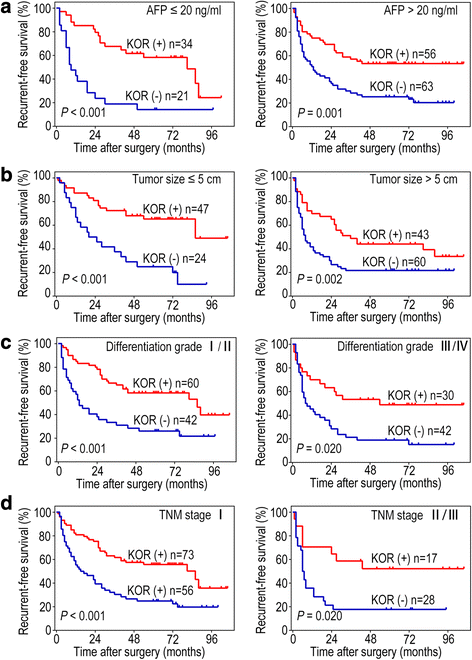Down-regulation of the tumour suppressor κ-opioid receptor predicts poor prognosis in hepatocellular carcinoma patients
- PMID: 28821282
- PMCID: PMC5562986
- DOI: 10.1186/s12885-017-3541-9
Down-regulation of the tumour suppressor κ-opioid receptor predicts poor prognosis in hepatocellular carcinoma patients
Abstract
Background: Opioid receptors have become increasingly implicated in cancer progression and long-term patient outcomes. However, the expression and significance of the κ-opioid receptor (KOR) in hepatocellular carcinoma (HCC) remain unclear.
Methods: In this study, KOR mRNA expression was analysed by real-time quantitative PCR in 64 pairs of HCC tumour tissues and adjacent non-tumour tissues, and KOR protein expression was analysed by immunohistochemistry in 174 HCC patients. We investigated the correlation between KOR expression and clinicopathological parameters to illustrate the potential prognostic significance of KOR expression in HCC.
Results: KOR mRNA expression was significantly down-regulated in 79.69% (51 of 64) of the HCC tumour samples, and KOR expression in tumour tissue was significantly lower than that in adjacent non-tumour tissues (P < 0.001). ROC curve analysis showed that KOR mRNA expression yielded AUC of 0.745, for the detection of HCC patients. Low KOR mRNA expression in HCC was correlated with aggressive clinicopathological parameters, such as tumour size (P = 0.015), differentiation grade (P = 0.011), and TNM stage (P = 0.021). Moreover, down-regulation of KOR protein expression in HCC tissues was detected in 174 HCC patients. Similarly, negative KOR protein expression was significantly correlated with aggressive clinicopathological features, such as tumour size (P = 0.002), vascular invasion (P = 0.003), differentiation grade (P = 0.026), and TNM stage (P = 0.030). Furthermore, Kaplan-Meier survival analysis demonstrated that down-regulation of KOR in HCC indicated poor prognosis. KOR deficiency (KORT < N) was correlated to a shorter survival rate and an increased recurrence (both P < 0.001). In univariate and multivariate survival analyses, KOR was identified as a promising independent risk factor for both overall survival (OS, both P < 0.001) and recurrence-free survival (RFS, both P < 0.001).
Conclusions: Down-regulation of KOR in HCC tumour tissues has a strong association with poor prognosis and KOR might be a potential tumour suppressor.
Keywords: Hepatocellular carcinoma; Prognosis; Tumour suppressor; κ-opioid receptor.
Conflict of interest statement
Ethics approval and consent to participate
This study was approved by Committee for Ethical Review of Research at Sun Yat-sen University Cancer Center. All patients were informed of the analyses and provided written consent for the use of existing tissue samples in the present study. For those survival data were followed up via outpatient visit, written informed consents were obtained. Part of the survival data were obtained thorough telephone follow-up, the written informed consent could not be available due to the long journey from their resident to our hospital. Under these conditions, only verbal informed consents were obtained from these subjects or their legal guardians.
Consent for publication
Not applicable.
Competing interests
The authors declare that they have no competing interests.
Publisher’s Note
Springer Nature remains neutral with regard to jurisdictional claims in published maps and institutional affiliations.
Figures





Similar articles
-
Down-regulation of long non-coding RNA GAS5-AS1 and its prognostic and diagnostic significance in hepatocellular carcinoma.Cancer Biomark. 2018;22(2):227-236. doi: 10.3233/CBM-170781. Cancer Biomark. 2018. PMID: 29660898
-
H2.0-like homeobox 1 acts as a tumor suppressor in hepatocellular carcinoma.Tumour Biol. 2016 May;37(5):6419-28. doi: 10.1007/s13277-015-4490-z. Epub 2015 Dec 2. Tumour Biol. 2016. PMID: 26631039
-
Neuron-glial antigen 2 overexpression in hepatocellular carcinoma predicts poor prognosis.World J Gastroenterol. 2015 Jun 7;21(21):6649-59. doi: 10.3748/wjg.v21.i21.6649. World J Gastroenterol. 2015. PMID: 26074703 Free PMC article.
-
MCM family in HCC: MCM6 indicates adverse tumor features and poor outcomes and promotes S/G2 cell cycle progression.BMC Cancer. 2018 Feb 20;18(1):200. doi: 10.1186/s12885-018-4056-8. BMC Cancer. 2018. PMID: 29463213 Free PMC article. Review.
-
CYP3A4 Gene Is a Novel Biomarker for Predicting a Poor Prognosis in Hepatocellular Carcinoma.Cancer Genomics Proteomics. 2017 Nov-Dec;14(6):445-453. doi: 10.21873/cgp.20054. Cancer Genomics Proteomics. 2017. PMID: 29109094 Free PMC article. Review.
Cited by
-
Androgen represses opioid growth factor receptor (OGFR) in human prostate cancer LNCaP cells and OGFR expression in human prostate cancer tissue.Am J Clin Exp Urol. 2018 Aug 20;6(4):164-171. eCollection 2018. Am J Clin Exp Urol. 2018. PMID: 30246052 Free PMC article.
-
The Kappa Opioid Receptor: A Promising Therapeutic Target for Multiple Pathologies.Front Pharmacol. 2022 Jun 20;13:837671. doi: 10.3389/fphar.2022.837671. eCollection 2022. Front Pharmacol. 2022. PMID: 35795569 Free PMC article. Review.
-
Comprehensive Analysis to Identify the Encoded Gens of Sodium Channels as a Prognostic Biomarker in Hepatocellular Carcinoma.Front Genet. 2022 Jan 21;12:802067. doi: 10.3389/fgene.2021.802067. eCollection 2021. Front Genet. 2022. PMID: 35126466 Free PMC article.
-
Systemic immune effects of anesthetics and their intracellular targets in tumors.Front Med (Lausanne). 2022 Jul 28;9:810189. doi: 10.3389/fmed.2022.810189. eCollection 2022. Front Med (Lausanne). 2022. PMID: 35966857 Free PMC article. Review.
-
Opioids in cancer: The κ‑opioid receptor (Review).Mol Med Rep. 2022 Feb;25(2):44. doi: 10.3892/mmr.2021.12560. Epub 2021 Dec 8. Mol Med Rep. 2022. PMID: 34878160 Free PMC article. Review.
References
MeSH terms
Substances
LinkOut - more resources
Full Text Sources
Other Literature Sources
Medical

